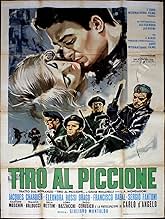Füge eine Handlung in deiner Sprache hinzuIn September 1943, young Marco Laudato enlists in the army of the Republic of Salò, even if he is not certain of his reasons. During training he and Elia, an older comrade, become friends. I... Alles lesenIn September 1943, young Marco Laudato enlists in the army of the Republic of Salò, even if he is not certain of his reasons. During training he and Elia, an older comrade, become friends. In one of the first retaliatory actions, he is wounded and is almost considered a hero. He ... Alles lesenIn September 1943, young Marco Laudato enlists in the army of the Republic of Salò, even if he is not certain of his reasons. During training he and Elia, an older comrade, become friends. In one of the first retaliatory actions, he is wounded and is almost considered a hero. He is taken to a hospital where he falls in love with Anna, the nurse who takes care of him.
Empfohlene Bewertungen
From a purely technical perspective, the cinematography performs a balancing act between the immediacy of documentary realism and the calculated beauty of painterly composition. Natural light is employed in ways that often strip images of gloss, flattening textures in a manner reminiscent of late-neorealist aesthetics, while at other moments the frame settles into carefully arranged tableaux where mise-en-scène conveys symbolic weight rather than narrative momentum. This alternation is striking, sometimes dissonant; in certain scenes the abrupt shift from gritty realism to stylization risks breaking immersion, but in the context of early '60s European cinema, the fluctuation mirrors the thematic duality at the film's heart.
The editing rhythm likewise oscillates, moving between languid observation and sudden bursts of visual and emotional intensity. These abrupt temporal shifts, more intimate in scope than the large-scale cross-cutting of The Longest Day (1962), serve not to convey the scale of war but the instability of personal recollection under extreme conditions. Occasionally, this structure can strain narrative cohesion, but it lends an authenticity to the psychological disorientation experienced by the characters. The sound design reinforces this instability: diegetic noises-distant shellfire, environmental disturbances-are often mixed to dominate over dialogue, creating a sensory imbalance reminiscent of Kanal (1957), though without that film's relentless claustrophobia.
Performances are understated to the point of austerity, eschewing the dramatic flourishes typical of Anglo-American WWII productions of the era. The effect is particularly strong in moments of moral tension, where silences and micro-expressions carry more weight than scripted exchanges. In some transitional passages, this restraint edges toward inertia, momentarily sapping narrative energy. Yet in ensemble scenes, the low-key approach yields a lived-in authenticity: characters interact as though under no obligation to perform for the audience, generating a believable texture of wartime coexistence. This sensibility recalls certain passages in Hell Is for Heroes (1962), though here the focus is less on solidarity than on the uneasy collisions of conflicting loyalties.
When the film was first released, Italian critics were sharply divided. Many praised its technical craft and willingness to challenge the heroic conventions of Resistance cinema, seeing it as a vital re-humanization of the war. Others attacked it for undermining patriotic narratives, accusing it of moral relativism or even revisionism. This was an era when Italian war films like La grande guerra (The Great War, 1959) could balance irony and tragedy while still reaffirming shared national values; the 1961 film's refusal to offer such reassurance left it vulnerable to political criticism. Abroad, reactions were more muted: in France and West Germany it was noted for its moral ambiguity and compared to works like Kanal, while in the UK and US-where WWII films still largely adhered to moral certainties-reviews tended to focus on its atmosphere and pacing rather than its political stance.
Its commercial impact in Italy was limited, but the film did not vanish. By the 1970s, a generational shift in both audiences and filmmakers allowed for a greater acceptance of morally complex war narratives. Retrospective critics began to see the film not as an uncomfortable anomaly but as an early forerunner of the micro-historical approach that became increasingly common in European WWII cinema. Its focus on small-scale events and moral dilemmas, once perceived as a weakness in an era of sweeping battlefront stories, was now recognized as prescient.
The visual style, once faulted for inconsistency, also gained new appreciation. By the late '70s and '80s, the alternation between realist grit and stylized framing was interpreted as a deliberate formal choice, a hybrid of neorealist inheritance and emerging modernist sensibilities. The irregular pacing, once criticized, came to be seen as a cinematic embodiment of wartime moral and psychological fragmentation. Academic interest grew steadily, and by the late '80s the film had been reclassified as an important transitional work in Italian WWII cinema-bridging the politically unified narratives of the late '40s and '50s with the fractured skepticism of the following decades.
Today, the film's reputation rests not on its commercial success but on its role as a work ahead of its time: technically assured yet thematically unsettling, shaped as much by the politics of its production year as by the war it depicts. In resisting easy categorization, it anticipated the more morally nuanced WWII cinema that would emerge across Europe in the decades to come, even if its own era was not fully ready for it.
Top-Auswahl
Details
- Laufzeit
- 1 Std. 54 Min.(114 min)
- Farbe
- Sound-Mix
- Seitenverhältnis
- 1.85 : 1












